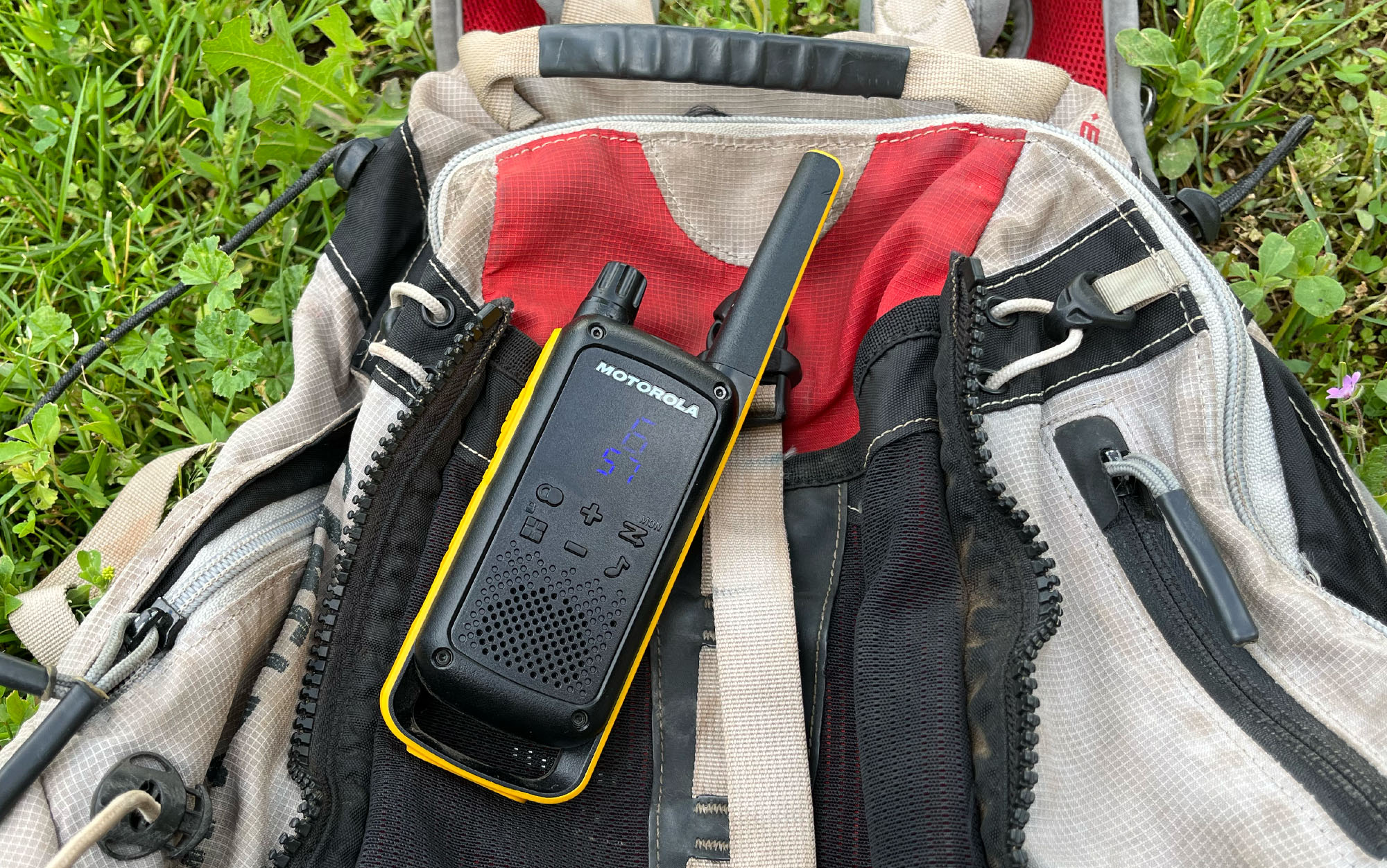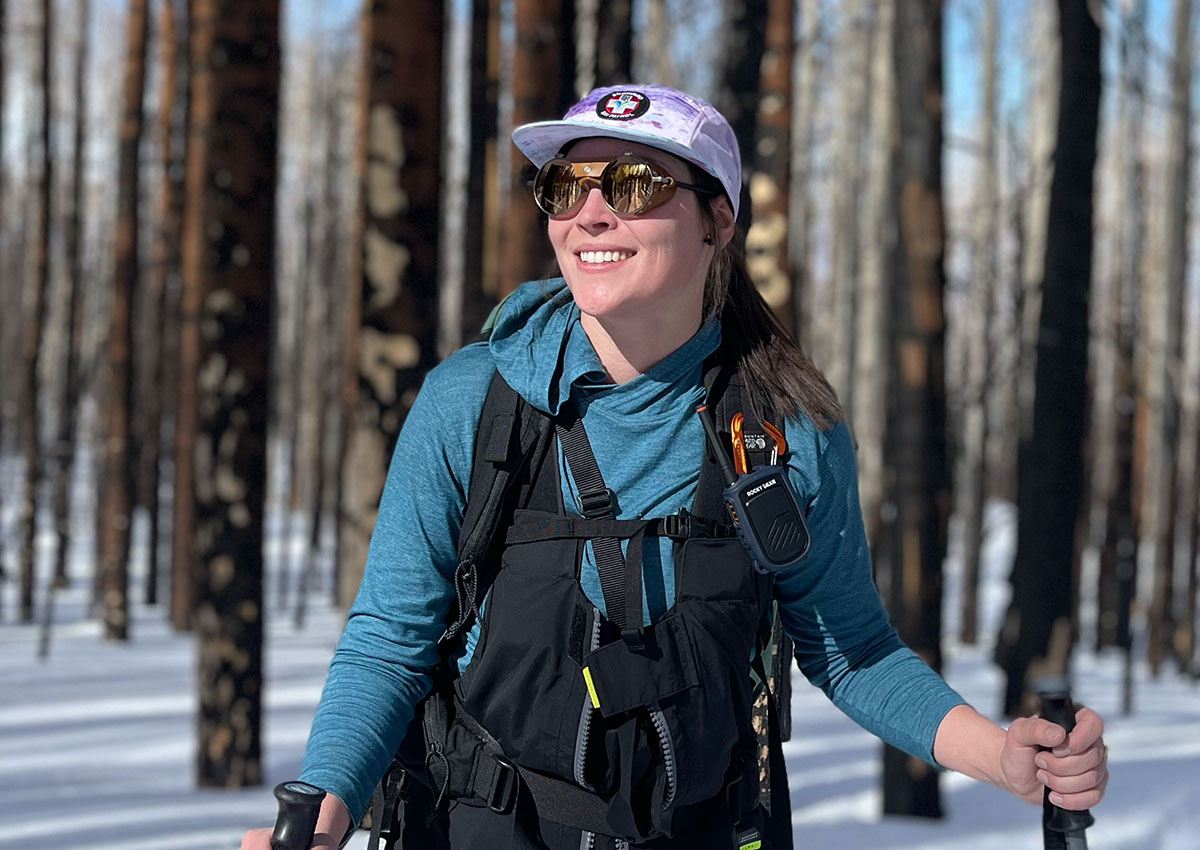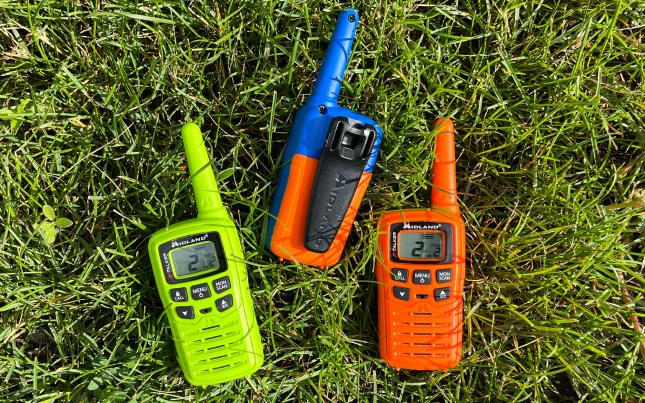We may earn revenue from the products available on this page and participate in affiliate programs. Learn More ›
Whether you’re scouting new hunting spots with your buddy or hiking with a partner, 2 way radios can keep your group connected while recreating outside. They provide a convenient way to inform your party of obstacles, forks, or meeting locations. Plus they’re tons of fun. If you have different hiking paces but want to chat, you can use a 2 way radio to shoot the shit. The best 2 way radios have crisp communication, a reliable range, and functional features. Here are my top picks.
- Best Overall: Rocky Talkie
- Best Lightweight: Midland X-Talker T10X3M
- Best Budget: Motorola Talkabout T470
How I Chose the Best 2 Way Radios

When selecting personal radios for outdoor excursions, I focused on license-free Family Radio Service (FRS) units. There are more powerful radios out there such as General Mobile Radio Service (GMRS) units but they require a license to operate. FRS radios use a standard set of 22 channels with fixed antennas utilizing a maximum of 2 watts of power. However, GMRS radios can use up to 5 watts, sometimes granting them a longer range. The walkie talkies on this list are license-free and popular amongst outdoor enthusiasts. I put them to the test while skiing, hiking, and attending crowded events to see just how well they actually operate in varying conditions.
Best 2 Way Radios: Reviews & Recommendations
Best Overall: Rocky Talkie
Best Overall
Rocky Talkie
Key Features
- Range: 25+ miles
- Over three days of battery life, even in very cold conditions (-20F)
- Weight: 4.8 ounces (radio only) 7.9 ounces (full system)
- 128 channels and 121 privacy codes
- IP56 water resistance
- Shatterproof LED screen
- Thermoplastic protective covering
- Ultralight carabiner and backup leash
- Two-year warranty
Pros
- Rugged
- Lightweight
- Ultralight carabiner
Cons
- Splashproof and snowproof, but not submergible
- Does not support NOAA weather channels
The Rocky Talkie is the best overall walkie talkie because it is rugged, lightweight, and reliable. Even with thick gloves on, the push-to-talk button is easy to depress and it is difficult to accidentally turn off as the power button is small and protected by raised plastic. The fact that it is rechargeable is also fantastic because you can top off the power for trips longer than three days. There’s a leash and ultralight carabiner to prevent drops, but even if it does fall, consequences are low as long as it doesn’t bounce off a cliff. There is no battery back panel to explode in all directions and they’re designed to be shatterproof and weatherproof. To save on weight, Rocky Talkies do not have access to NOAA weather alerts or channels so come prepared or have another method to receive weather updates.

Let’s talk about the advertised range on 2 way radios. If you’re in an empty, sprawling field and your friend is standing 25 miles away, you’ll likely be able to talk to them. The advertised range means a line of sight with no interference. However, trees, mountains, hills, and buildings can interrupt your transmission. Therefore, Rocky Talkie says their max range is over 25 miles, but 1 to 5 miles is more typical in backcountry terrain. When skiing, mountain biking, trail running, or otherwise recreating in a mountainous region, you’ll typically be able to communicate when your party is on the same side of the mountain and lose service if you’re separated by the peak.
I use these regularly for skiing and hiking. They perform well relaying crisp messages and peace of mind. It is not uncommon here in Salt Lake City to meet up with a group for an activity and everyone turns a few out of their pockets. They are a popular piece of gear that keeps groups together in many regions and climates. Pro tip: Put a colorful piece of tape on yours so they make their way back to you post-ride.
Best Lightweight: Midland X-Talker
Best Lightweight
Midland X-Talker
Key Features
- Range: 20 miles
- 22 channels and 38 privacy codes
- NOAA weather alerts
- Water resistant
- Three-year warranty
- VOX capable
Pros
- Comes in three different colors
- Great price
- Small size
- Removable belt clips
Cons
- Needs three AAA batteries (not included)
- Not as clear
- Poor VOX capability
The Midland X-Talker three pack is only $50 and comes in three fun colors: green, orange, and blue. This helps distinguish who’s walkie is who’s and the bright colors make them easy to find. Each requires three AAA batteries which can be a nice alternative to rechargeable radios because you can simply slip in new batteries without waiting to charge up more juice. While these do include useful features like channel scan, call alert, and a roger beep, you might find yourself using the silent operation and keypad lock features most as the buttons are easily pressed and annoying sounds emitted.
However, if you’re planning a family camping trip or going on a day hike, these little walkies are great for keeping your group together for a good price. They work well and have a host of features. Just hold the button down longer than you might think before the beginning and after the end of your message. Some crunchy messages are part of the fun, but you should keep a very respectable range on these for best function. I wouldn’t recommend testing these in snow as they don’t have a proper IP rating or insulation for the battery compartment. But, the NOAA weather features can give you some peace of mind in sneaky summer storms.
At only 4 ounces each, these are a no-brainer to throw in your pack before a group activity. As long as you’re staying close and in fair weather, these will operate nicely on day hikes. Bring plenty of extra batteries for an extended camping trip though because you’ll likely get 10 hours maximum out of the AAAs depending on your channel’s frequency and how often you’re conserving the battery by powering down. The VOX mode is meant to allow you to speak directly to the device instead of using the push to talk button; however, my lips had to almost touch the device for it to pick up my message rendering it relatively useless.
Best Budget: Motorola Talkabout
Best Budget
Motorola Talkabout
Key Features
- Range: 35 miles
- 28 hours of battery life
- IPX4 waterproof rating
- Built-in LED flashlight
- NOAA Weather channels and alerts
- 22 channels and 121 privacy codes
- Emergency button
- iVOX capability (voice-operated exchange)
Pros
- Weatherproof
- Flashlight
- Emergency button
Cons
- Only 28 hours of battery life
- iVOX performs poorly

At 6.7 ounces, the Talkabout is lightweight enough for day trips and has tons of interesting features. The flashlight is my favorite of these features. Having a small beam of light easily accessible at all times is extremely handy on camping trips. It’s bright enough to find something on the ground or in your bag, locate a trail marker, or read a map. Motorola also includes personalizable stickers to mark your device. The emergency button will send out an alarm signal to your group’s radios.
One feature that is worth exploring, but maybe not relying on is the iVOX technology. On this setting you’re able to simply speak aloud and the radio will pick up your voice and relay it to others on a slight delay, no button pushing necessary. There are three noise sensitivity settings: low, medium, and high. But when I attempted to hook the radio on my shoulder on the highest sensitivity level and speak, the other radio simply clicked at me and did not communicate my message. You must speak directly into the microphone for the iVOX to pick up your message, which in my opinion defeats the purpose. Even the headset does not get the microphone close enough to my mouth to pick up words.
Motorola advertises that the Talkabout is capable of communicating up to 35 miles from peak to valley and up to 6 miles on open water. In a neighborhood, you can expect up to 2 miles. While the range is comparable to a Rocky Talkie, they are not as rugged or weatherproof. However, they are much cheaper. For a great value and fun features, these are the best budget 2 way radios on this list.
Things to Consider Before Choosing the Best 2 Way Radios
Emergencies
Two way radios allow you to communicate in the backcountry without radio or cell towers. These devices can be extremely helpful when tackling a tough mission. You’re able to alert your group to obstacles, weather, directions, and more while out of service. While these are handy for communication, do not rely solely on 2 way radios in an emergency. Sure, there is a chance you can reach someone to call for help. But the extremely limited range, lack of emergency channel, and lack of GPS means these are not as reliable or effective as a satellite messenger or personal locator beacon.
If you are in an emergency situation, channel 9 is an unofficial emergency channel that you can attempt to contact. Use your radio’s scan button to find channels in use and stay off any privacy channels for a better chance at reaching someone. The Motorola Talkabout features an emergency button that when held down sends an alarm sound to all the radios. This is helpful to alert your group that you’re lost or hurt, but it will not send out a magic alert message to authorities. Unfortunately, 2 way radios will really only allow you to stay in contact with your group for a short range while they find and return with help.
Stay smart in the backcountry and be prepared for your surroundings. Having a walkie talkie will not ensure you are found if an emergency abounds. Also please be wary that nothing you say on these radios is private. Anyone with a radio on the same channel can hear what you’re saying. Do not share personal details or information about your location willy-nilly. You wouldn’t want someone lurking on your channel to take advantage of sensitive information.
IP Rating
IP ratings are how dust and water resistant the device is. For instance, the Rocky Talkies have an IP rating of IP56. This means on a scale of 0 (not dust resistant) to 6 (dust proof), Rocky Talkies are a 5 (dust protected). And on a scale of 0 (not water resistant) to 8 (submersible up to 3 meters for up to 30 minutes), the Rocky Talkie is a 6 (protected from a 12.5 liters per minute water stream). If there is an X in the IP rating, it means it has not been tested for that circumstance. The Motorola Talkabout has an IPX4 rating meaning the device is protected from omnidirectional water splashes, but not tested in a dusty environment.
Battery
Your 2 way radio is only as effective as its battery life. If you’re planning a backpacking trip, you’ll have to recharge the Motorola Talkabout every night. The Rocky Talkie will likely last your entire weekend trip. The Midland X-talker takes three AAA batteries which would last you about 7-8 hours on the lowest wattage channel: 0.5 watts. These license-free FRS radios only use up to 2 watts of power maximum, but using them all day or keeping them on overnight are sure-fire ways to drain your battery. Stay vigilant about battery life, or you could find yourself cut-off from the group.
Range
As I have explained in the relevant product descriptions, the advertised range of 2 way radios is drastically different from their performance range in the backcountry. If you’re hiking a highline trail up, over, and down peaks all day, you will have a very low or non-existent range with your hiking partners. For the best results, stay within a mile or two of each other and on the same side of mountains, hills, buildings, and other obstacles.
FAQs
All walkie-talkies are two-way radios, but not all two-way radios are walkie-talkies. A two-way radio allows you to send and receive radio signals while a walkie-talkie is defined as a portable two-way radio. This is to account for table-top or vehicle mounted two-way radios that are inherently stationary, not portable. However, the terms are used interchangeably.
You do not need a permit to use the best two-way radios on this list. Family Radio Service (FRS) units do not require a license. However, if you upgrade to a more powerful General Mobile Radio Service (GMRS) unit, you will need to obtain a license.
Yes, two-way radios are great for boating. Cell signal on the ocean is almost nonexistent, so walkie talkies can give a fleet the opportunity to communicate from different vessels as long as they are in range. Be sure to select a waterproof radio for use at sea or store it in a dry bag.
Read Next: The Best Emergency Radios of 2023
Why Trust Outdoor Life?
Since 1898, OL has been a leading authority in testing and reviewing hunting gear, fishing tackle, guns and shooting equipment, and much more. We have more than a century-long history of evaluating products, and we’re now bringing that expertise to online reviews. Our editors are experienced outdoorsmen and women, and most importantly, we’re trained journalists. We prioritize field testing and objective data when reviewing products. We conduct interviews with gear manufacturers and engineers as well as outdoor experts so that our readers have an understanding of how and why a product works—or doesn’t.
Advertising does not influence our gear reviews and it never will. While we always focus our coverage on standout products—because we want our readers to be aware of the latest and greatest gear—we also cover the flaws and quirks of any given product.
Final Thoughts
Two way radios are convenient and fun in tons of scenarios. Whether you’re looking for your friends at a crowded concert with no reliable service, hiking along a long trail with a large group, or skiing a line in segments for avalanche safety, communication is key outdoors.
- Best Overall: Rocky Talkie
- Best Lightweight: Midland X-Talker T10X3M
- Best Budget: Motorola Talkabout T470






